…flies in on a broom!
.
.
[Note: Any passages in Italian are followed by a translation in English.]
.
Yes, the lore of la Befana is one of my favorite parts of the Italian winter holiday traditions. So, while I’m en route flying back home (on a plane, not a broom) from the holidays, it seems like a great time to tell the tale of that beloved Italian ‘Epiphany witch.’ Befana is the folk character who rides in on a broom on the eve of January 6th, coinciding with l’Epifania, (Epiphany), the date when i re magi (the wisemen) are said to have arrived in Bethlehem.
.
She is usually depicted as a smiling old lady riding a broomstick through the air, bent over, with long, straggly hair and covered in soot because she enters children’s houses through the chimney. She fills Italian kiddies’ calze (stockings), delivering presents – mostly candies, chocolates, fruit and small trinkets to the bambini bravi (good kids) – and a lump of carbone (coal) or black-colored candy for bambini cattivi (naughty kids). (‘Simile al carbone finto che ho dato ai miei fratelli e nipote per scherzo insieme ai loro regali’… Similar to the fake coal I gave my brothers and nephew as a joke along with their gifts!)
.
.
Dunque (So then), this might be rather a brief blog post, or not, as I compose it and pay homage to la Befana between planes, layovers, and delays while I journey from the frozen heartland of Wisconsin to San Diego on the eve of the Epiphany. (Currently I’m getting a bit of extra electricity to my laptop as I wait in the airport for the snow-delayed aircraft to land in Milwaukee(!) Uffa! (Darn it!)
.
Befana & the 3 Kings
Allora (Well then), back to la Befana…legend has it that la Befana lived on the route the tre magi took when they set out to visit il Gesù Bambino (the Infant Jesus). They stopped at her house to ask her for directions to Bethlehem as well as for food and shelter.
.
.
However, la Befana wasn’t in a very sociable mood just then, and she sent them on their way. Later, she had a change of heart and decided she wouldn’t mind entertaining a few guests after all. But by then the guests were far beyond recall. Befana decided to go after them in any case and set off for Bethlehem. Like them, she followed la stella cometa (the guiding star), but unlike them she was unable to find the stable where the Christ Child lay.
.
.
Befana however wasn’t the sort to give up and is still flying around looking through windows and down chimney tops. She visits every house where there are children and leaves gifts just in case one of them happens to be the Christ Child. For the naughty children it is said she only leaves coal – but that is very rare, since there are very seldom any really naughty children, especially during Christmas time, when they know Befana is on her way.
.
Origins of la Befana
While the legend of la Befana is a charming one, it is definitely somewhat exotic, and seems to me like it could be a blending of different stories and traditions over the centuries as the winter holiday season in Italy morphed from the celebrations of the Roman Empire’s pagan practices to those of modern Christian times.
.
.
During Roman times, the winter holiday season lasted almost a month, starting with the festival of Saturnalia (winter solstice celebration), that kicked off on December 17, and going until the end of Lupercalia (end-of-winter festival), on January 15. This period was marked by wild revelry and lots of eating, drinking, and merrymaking (definitely some similarities to modern times), and also featured the honoring of various goddesses.
.
Perhaps la Befana is a holdover of the female figures celebrated as a part of the tapestry of this season in times past. Doing a bit of digging, I found that there is indeed evidence suggesting Befana’s connection to the ancient Roman goddess Strenia, who presided over the New Year’s gifts, delivering the same types of goodies that the current-day Befana does now.
.
.
Befana vs. Babbo Natale
Babbo Natale (Santa Claus or Father Christmas) is a relative newcomer on the holiday scene in Italy… I have heard that one early glimpse of Santa in Italy was by way of American servicemen in Italy during the WWII years, who would dress up as Santa Claus at Christmastime and give out presents to children. Prior to that point, la Befana was the main bringer of presents, and in this sense, Babbo Natale is somewhat of an interloper.
.
.
While many families still practice the tradition of la Befana and put out their calze before bed on the eve of Jan. 6, she is not as key a player in her role of ‘bringer of holiday goodies’ as she once was. In many parts of Italy she has been replaced or overshadowed by Santa. But since she has been around delivering the holiday loot for more than 2000 years, chances are she’ll be an important figure for many more to come.
.
Befana la Befania….
One more role that la Befana plays is to officially usher out the holiday season in Italy. Diversely from the United States, where the holiday season ends after New Year’s day, in Italy it continues through January 6th. Therefore, the Epiphany, or la Befana as it is colloquially referred to, marks the end of the Italian winter holidays. In fact there’s a rhyme to that extent: “Befana e Befania, tutte le feste se le porta via,” meaning that la Befana (the present-delivering witch) and Befania (another name for Epiphany, derived from Latin and Greek) take or carry all the holidays away with them when they leave. Or, like I said at the beginning of this post, it’s not over ‘til the old lady flies in on a broom!
.
Any thoughts or comments on the Befana? I’d love to hear ‘em! Please leave comments below (beneath the sign-up form).
.
consider using powerpoint joke from don nealon about the ‘regine magie’

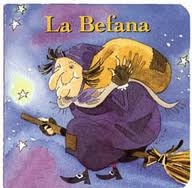



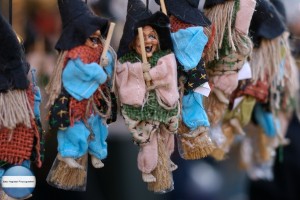
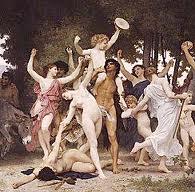
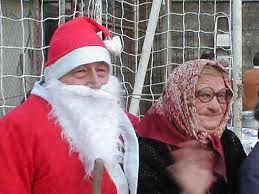

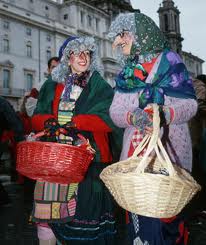


Pingback: Epifania: tutte le feste porta via | UrbanSchool.it
Pingback: Tweets that mention Italian Holidays>> It’s not over ’til the old lady… | Italiano With Jodina -- Topsy.com
What a delightful storia, Jodina. Specialmente, che la Befana e stata a felice figurina. Ci sono troppo witches nei storie antiche chi sono brute e cattivi. Befana e differente. Grazia xxx
Spero quando ritornera a sua casa, sta serra, sera calze con regali per ti.
Ciao June! Sono d’accordo con te… non tutte le streghe sono cattive! La Befana e` un buonissimo esempio 🙂